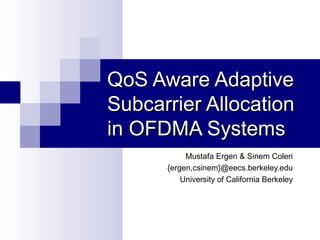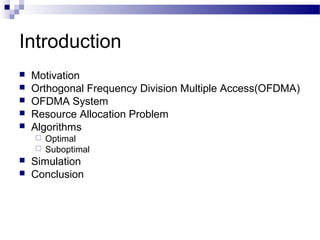Ofdma 1
- 1. QoS Aware AdaptiveQoS Aware Adaptive Subcarrier AllocationSubcarrier Allocation in OFDMA Systemsin OFDMA Systems Mustafa Ergen & Sinem Coleri {ergen,csinem}@eecs.berkeley.edu University of California Berkeley
- 2. Introduction ? Motivation ? Orthogonal Frequency Division Multiple Access(OFDMA) ? OFDMA System ? Resource Allocation Problem ? Algorithms ? Optimal ? Suboptimal ? Simulation ? Conclusion
- 3. Motivation ? Broadband Wireless Access ?Ex: IEEE 802.16, Wireless MAN ? OFDM ?Eliminates InterSymbol Interference ? OFDMA
- 4. OFDM Diagram
- 5. Multiuser OFDM ? OFDM-TDMA ? OFDM-FDMA ? OFDMA User 1 User 2 User 3 Subcarrier Time OFDM-TDMA Subcarrier Time OFDM-FDMA Subcarrier Time OFDMA Ą Ą
- 6. Resource Allocation Goals: ? Dynamic subcarrier selection ? Improve system performance with adaptive modulation ? More bits transmitted in large channel gain carriers ? Provide QoS ? Rate and BER
- 7. Resource Allocation Assumptions: ? Base station knows the channel ? Base station informs the mobiles for allocation Base Station subcarrier user
- 8. System Application Network Resource Allocation Physical Layer rQoS=[rR,rBER] oQoS=[oR,oBER,oCoS] oCoS=Ptotal for downlink oCoS=Pu for uplink [User x Subcarrier]
- 9. OFDMA
- 10. Resource Allocation 64-QAM 16-QAM 4-QAM Channel Subcarrier User RATE: [12 6 6 8 ] BER: [1e-2 1e-2 1e-4 1e-4] QoS Resource Allocation
- 12. Optimal ? Integer Programming ĄÆĄÆ ĄÆĄÆ ĄÆĄÆĄÆ = = = = = = = ĄÜĄÜ = ĄĘ K k M c cnk cnk N n M c nkk cnkcnk K k N n M c nk nk nallforand kallforcRtosubject for cf cnk 1 1 ,, ,, 1 1 , ,,,, 1 1 1 2 , , .,10 ,. }1,0{ )( min ,, ĶÃ ĶÃ ĶÃĶÃ ĶÁĶÃ Subcarrier User Subcarrier User Subcarrier User Subcarrier Use Pc2 Pc3 Pc1
- 13. Motivation for Sub-optimal Algorithms ? IP is complex ? Allocation should be done within the coherence time ? Time increases exponentially with the number of constraints
- 14. Current Suboptimal Algorithms 2-step: ? Subcarrier Allocation ?Assume the data rate for all subcarriers ?Assume modulation rate is fixed ?Assign the subcarriers ? Bit Loading ?Greedy approach to assign the bits of user
- 15. Current Suboptimal Algorithms ? Subcarrier Allocation ? Hungarian algorithm ? Optimal, very complex ? LP approximation to IP problem ? Close to optimal ? Bit Loading Subcarrier User Subcarrier User Subcarrier User).( 1 )(minarg :, ,, ,, ,, nknk nknk nknk Sn k cPevaluate cc cPn timesRfollowingtherepeatkeachFor k ? += ?= ĄĘ
- 16. Problems in Current Suboptimal Algorithms ? Subcarrier assignment and bit loading are separated ?Users with bad channels may need higher number of subcarriers ? Not iterative subcarrier assignment
- 17. Iterative Algorithm Iterative algorithm based on ? Assignment of bits according to highest modulation ? Finding the best places ? Distributing the assigned bits to other subcarriers or to non-assigned subcarriers ? Exchanging the subcarriers among user pairs for power reduction.
- 18. Iterative Algorithm ? Fair Selection(FS) ? Greedy Release(GR) ? Horizontal Swaping(HS) ? Vertical Swaping(VS)
- 20. Simulation Environment Build the OFDMA system ? Modulations:4-QAM,16-QAM,64-QAM ? Independent Rayleigh fading channel to each user ? Number of subcarriers =128 ? Nodes are perfectly synchronized
- 21. CDF of total transmit power without Pmax constraint
- 22. CDF of total transmit power with Pmax constraint
- 23. Average bit SNR vs. RMS delay spread As RMS delay spread increases, the fading variation increases hence higher gains are obtained by adaptive allocation
- 24. Average bit SNR vs. number of users As the number of users increases, the probability of obtaining good channel at a subcarrier increases
- 25. Instantaneous Average bit SNR vs Time Iterative Algorithm improves its Average Bit SNR by the time.
- 26. Conclusion ? OFDMA ? Broadband Wireless Access ? Resource Allocation ? Channel Information ? QoS Requirement ? Optimal Algorithms ? complex ? Iterative Algorithms
Editor's Notes
- #3: The analysis, Research and consultancy (ARC) group forecasts that the fixed wireless deployments in both homes and business will reach 28 million by 2005. 802.16 comiitee broadband wireless access based on OFDMA.
- #4: BWA is alternative to DSL technologies Physical layer should mitigate non LOS environments in indoor. 802.16 10-66GHz 802.16a 2-11GHz
- #7: Instead of assigning a fixed frequency or time slot to each user, the performance will increase. The users will not use the subcarriers that are in deep fade. The performance will increase since it is quite unlikely that this subcarriers will be in deep fade for all the other users.








![System
Application
Network
Resource Allocation
Physical Layer
rQoS=[rR,rBER] oQoS=[oR,oBER,oCoS]
oCoS=Ptotal for downlink
oCoS=Pu for uplink
[User x Subcarrier]](https://image.slidesharecdn.com/ofdma-1-150515081652-lva1-app6892/85/Ofdma-1-8-320.jpg)

![Resource Allocation
64-QAM
16-QAM
4-QAM
Channel
Subcarrier
User
RATE: [12 6 6 8 ]
BER: [1e-2 1e-2 1e-4 1e-4]
QoS
Resource Allocation](https://image.slidesharecdn.com/ofdma-1-150515081652-lva1-app6892/85/Ofdma-1-10-320.jpg)















